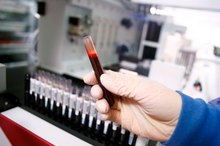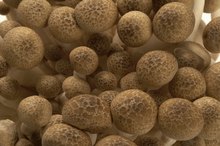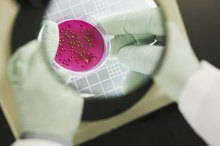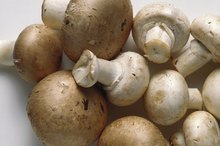What does fact checked mean?
At Healthfully, we strive to deliver objective content that is accurate and up-to-date. Our team periodically reviews articles in order to ensure content quality. The sources cited below consist of evidence from peer-reviewed journals, prominent medical organizations, academic associations, and government data.
- Evidence-Based Complementary and Alternative Medicine: The Pharmacological Potential of Mushrooms
- Evidence-Based Complementary and Alternative Medicine: The Pharmacological Potential of Mushrooms
The information contained on this site is for informational purposes only, and should not be used as a substitute for the advice of a professional health care provider. Please check with the appropriate physician regarding health questions and concerns. Although we strive to deliver accurate and up-to-date information, no guarantee to that effect is made.
Mushrooms That Are Antiviral
Mushrooms are a diverse collection of fungi, constituting many thousands of species. Mushrooms have been consumed for medicinal purposes for countless generations, especially in Asian countries, although only a small percentage have been scientifically investigated. Mushrooms display a variety of medicinal properties including antiviral, antibacterial, antitumor, anti-allergic, anti-inflammatory, hypoglycemic and immune-stimulating behavior. On the other hand, some mushrooms are psychoactive, while others are poisonous, so caution is always advised. Consult with a practitioner of traditional Chinese medicine to better understand the properties of mushrooms.
Antiviral
Antiviral compounds are used to treat viral infections, however, not all antivirals are effective against all viruses. Unlike most antibiotics that kill bacteria, antiviral compounds generally do not destroy their target pathogen; rather, they inhibit the development or reproduction of the virus, according to the “Textbook for Functional Medicine.” Because:
- viruses use the host’s cells to replicate
- safe
- effective antiviral compounds must be able to interfere with the virus without harming the host tissues [1](# 'inline-reference::Textbook for Functional Medicine; David S
Jones').
Antiviral Properties of Mushrooms
Antibiotics That Kill or Reduce Parasites
Learn More
Antiviral effects have been discovered not only for whole mushrooms, but also for extracts of isolated compounds within mushrooms, according to the “Mayo Clinic Book of Alternative Medicine.” Direct antiviral effects include inhibition of viral enzymes, synthesis of viral nucleic acids and adsorption or uptake of viruses 2. Indirect antiviral effects are achieved by stimulating the immune response against the viral invasion and promoting biochemical factors, such as alkalinity, that discourage viral replication. 23”
Antiviral Mushrooms
The primary mushrooms showing promise for their antiviral properties are called polypores, which are considered to be the ancestors of most gilled mushrooms. A particularly powerful mushroom that has been identified as inhibiting the activity of the herpes simplex I and II viruses, varicella zoster virus, influenza-A virus and the respiratory syncytial virus is Rozites caperata or the Gypsy Mushroom, according to a study published in a 2000 edition of the journal “Recent Research Developments in Antimicrobial Agents and Chemotherapy.” Other mushrooms that demonstrate antiviral activity include:
- Lentinula edodes or Shiitake mushroom
- Grifola frondosa or Maitake mushroom
- Ganoderma lucidum or Mannentake mushroom
- Trametes versicolor
- Reishi mushrooms 4
Complications
Five Types of White Blood Cells
Learn More
Many of the mushroom species that display antiviral properties are long-term residents of “Old Growth” forests, such as those seen in Washington State, Oregon and Northern California in the United States. They play important roles in recycling the elements within decomposing trees. A complication of using these types of mushrooms for natural antivirals is that they are difficult or impossible to cultivate due to their complex interdependence with their host trees, according to the book “Chinese Herbal Medicine: Materia Medica. 5”
- Many of the mushroom species that display antiviral properties are long-term residents of “Old Growth” forests, such as those seen in Washington State, Oregon and Northern California in the United States.
Related Articles
References
- Textbook for Functional Medicine; David S. Jones
- Mayo Clinic Book of Alternative Medicine - 2nd Edition; Brent Bauer M.D.
- Evidence-Based Complementary and Alternative Medicine: The Pharmacological Potential of Mushrooms
- Recent Research Developments in Antimicrobial Agents & Chemotherapy: Mushroom Antivirals
- Chinese Herbal Medicine: Materia Medica; Dan Bensky, et al.
- Fun with funghi: Garnish your meals with mushrooms. Academy of Nutrition and Dietetics. Updated January 17, 2019.
- Mushrooms, raw. FoodData Central. U.S. Department of Agriculture. Published April 1, 2019.
- Nakashima A, Yamada K, Iwata O, et al. β-Glucan in foods and its physiological functions. J Nutr Sci Vitaminol. 2018;64(1):8-17. doi:10.3177/jnsv.64.8
- Lo HC, Wasser SP. Medicinal mushrooms for glycemic control in diabetes mellitus: History, current status, future perspectives, and unsolved problems (review). Int J Med Mushrooms. 2011;13(5):401-26. doi:10.1615/IntJMedMushr.v13.i5.10
- Institute of Medicine (US) Panel on Micronutrients. Dietary Reference Intakes for vitamin A, vitamin K, arsenic, boron, chromium, copper, iodine, iron, manganese, molybdenum, nickel, silicon, vanadium, and zinc. Washington (DC): National Academies Press (US); 2001.
- Potassium. Fact Sheet for Professionals. National Institutes of Health Office of Dietary Supplements. Updated March 2, 2020
- Iron. Fact Sheet for Professionals. National Institutes of Health Office of Dietary Supplements. Updated December 19, 2019
- Wasser SP. Medicinal mushroom science: History, current status, future trends, and unsolved problems. Int J Med Mushrooms. 2010;12(1):1-16. doi:10.1615/IntJMedMushr.v12.i1.10
- Chaturvedi VK, Agarwal S, Gupta KK, Ramteke PW, Singh MP. Medicinal mushroom: Boon for therapeutic applications. 3 Biotech. 2018;8(8):334. doi:10.1007/s13205-018-1358-0
- Cheung PCK. The nutritional and health benefits of mushrooms. Nutr Bull. 2010;35(4):292-299. doi:10.1111/j.1467-3010.2010.01859.x
- Kalaras MD, Richie JP, Calcagnotto A, Beelman RB. Mushrooms: A rich source of the antioxidants ergothioneine and glutathione. Food Chem. 2017;233:429-433. doi:10.1016/j.foodchem.2017.04.109
- Feng L, Cheah IK, Ng MM, et al. The association between mushroom consumption and mild cognitive impairment: A community-based cross-sectional study in Singapore. J Alzheimers Dis. 2019;68(1):197-203. doi:10.3233/jad-180959
- Vitamin D. Fact Sheet for Professionals. National Institutes of Health Office of Dietary Supplements. Updated March 24, 2020
- Keegan RJ, Lu Z, Bogusz JM, Williams JE, Holick MF. Photobiology of vitamin D in mushrooms and its bioavailability in humans. Dermatoendocrinol. 2013;5(1):165-76. doi:10.4161/derm.23321
- McRae MP. Dietary fiber intake and type 2 diabetes mellitus: An umbrella review of meta-analyses. J Chiropr Med. 2018;17(1):44-53. doi:10.1016/j.jcm.2017.11.002
- Ferreira H, Alves M, Pineda F et al. Cross-reactivity between molds and mushrooms. Pediatr Allergy Immunol and Pulmonol. 2017;30(2):126-128. doi:10.1089/ped.2017.0746
- North American Mycological Association. Mushroom poisoning syndromes.
- Nardozzi, C. The National Gardening Association. Learning Library. Edible Landscaping - Edible of the Month: Two Simple, Beginner Mushrooms.
- Mushrooms, canned. FoodData Central. U.S. Department of Agriculture. Published April 1, 2019.
Writer Bio
Sirah Dubois is currently a PhD student in food science after having completed her master's degree in nutrition at the University of Alberta. She has worked in private practice as a dietitian in Edmonton, Canada and her nutrition-related articles have appeared in The Edmonton Journal newspaper.









